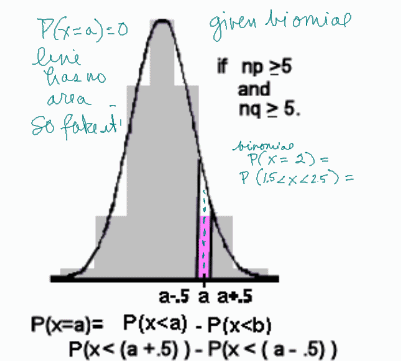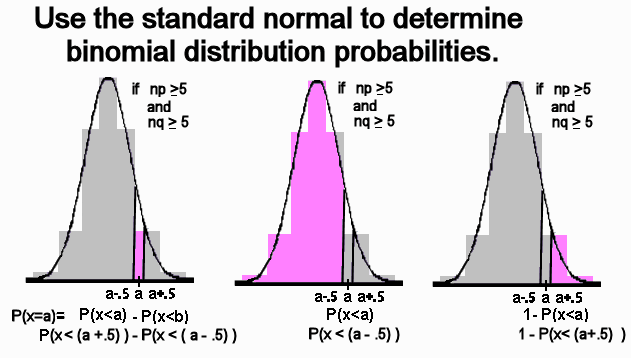-
Use the Normal to Compute the Binomial.
-
- Using the normal to compute the binomial is an important
mathematical idea but now an old computational technique. For the most part, calculators functions have replaced statistical tables as
sources for values of probability distributions.
-
- It is valuable to know that for large values of n, the discrete binomial distribution
approaches the continuous normal distribution.
-
- When n(p) >5 and n(q) >5, the normal distribution may be used to approximate
the binomial. This technique is useful when:
- binomial tables are not available for the given n,
- the numbers for n is large, or
- computation is required for more than 1 value of x, as in p(x>2), since repeated use of the
formula or even the tables might be a pain.
- The normal distribution does not match the binomial distribution, but, for larger values of n the shape
matches closer and closer.

-
- In each distribution, the probability is the area under the curve. For the binomial distribution
(which is discrete), each value of x has a thickness on the x axis. For the normal distribution (which is continuous), each value of x has
one one point on the x-axis where a vertical line crosses the axis.
-
- Since a line does not have an area (the vertical line x=2 to compute p(x=2), for example), one must
use an interval (the interval 1.5 < x < 2.5 to compute p(1.5 < x < 2.5), for example) to compute the probability.
-
- Because of the above, to use this technique, one must rewrite the binomial probability expression
to match an expression which can be evaluated by a normal probability expression.
-
- This technqiue requires taking the statement of equality (one which inlcudes =) and
rewriting it as a statement of inequality (one which includes >, <, >, or <, or multiple statements of inequality. The figures below
depict this technique.
-

|



![[MC,i. Home]](http://www.mathnstuff.com/math/spoken/here/1gif/mcihome.gif)
![[Table]](http://www.mathnstuff.com/math/spoken/here/1gif/table.gif)
![[Words]](http://www.mathnstuff.com/math/spoken/here/1gif/words.gif)

![[this semester's schedule w/links]](http://www.mathnstuff.com/gif/semestr.gif)
![[Good Stuff -- free & valuable resources]](http://www.mathnstuff.com/gif/goods.gif)
![[next]](http://www.mathnstuff.com/math/spoken/here/1gif/next.gif)
![[last]](http://www.mathnstuff.com/math/spoken/here/1gif/last.gif)